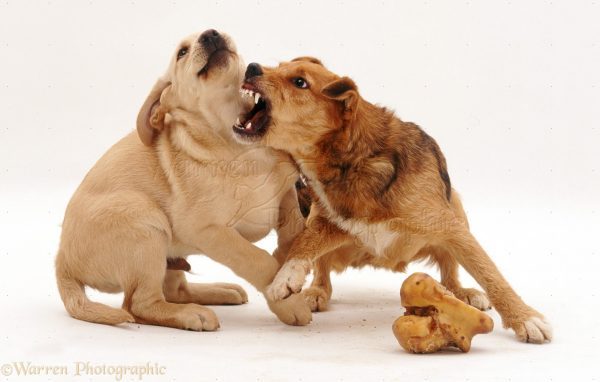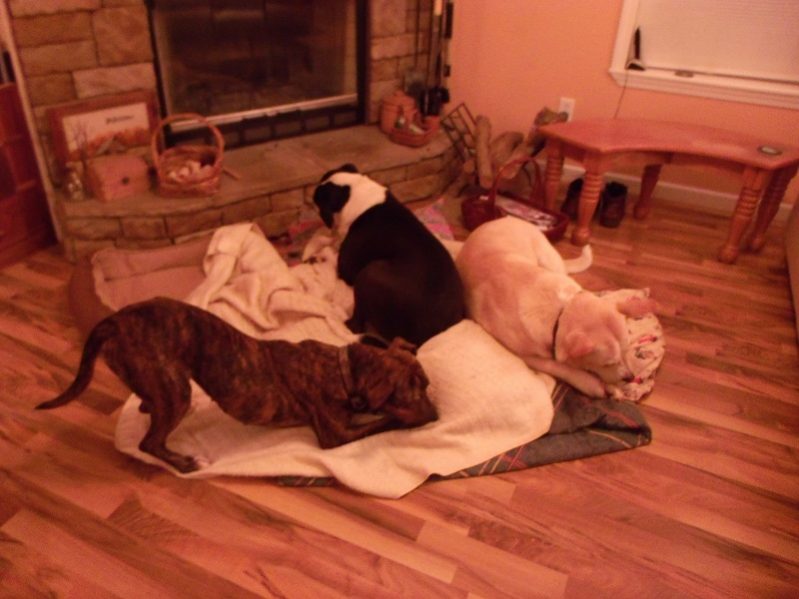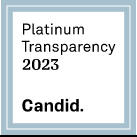
Dogs tend to protect or “guard” things they feel are most important to them, things they feel they can’t do without. Some will guard toys, some food, some will “guard” or become vicious when others approach their people. Guarding is rarely a desirable trait. Food guarding is dangerous to other dogs and to the people who care for the dog. It needs to be corrected.
Why Is the Dog Food Guarding?

Some dogs just have a greedy nature, even (perhaps especially) as a puppy. They don’t share well. Working with them as a puppy is needed to correct this early. Some dogs guard food because they came from an environment where food was scarce and they had to fight for every scrap they got. Some dogs guard because, although food is plentiful, others steal theirs.
Discovering why the dog guards is the key to undoing the behavior.
What NOT to do
When doing S.A.F.E.R. testing, we test for food aggression by giving them a bowl of food or a treat then taking it away, using a long-handled rubber hand. Their reaction determines their score.
When trying to correct food aggression, NEVER take the dish away once you’ve given it. It is best to not hand the bowl to the dog either, until you know it’s safe, for it may bite you in trying to acquire the food to begin with. Put the bowl on the floor before letting the dog in the room or out of their crate.
Don’t feed a food aggressive dog with other dogs, hoping the others will show them proper etiquette: at least not in close quarters.
Do not over-feed. Making a dog fat does not diminish food guarding. If the dog is underweight, then feed a little extra or use something like coconut oil to add caloric content. If the dog gets used to double portions, you will reinsert anxiety when you have to cut back later on.
Minimize Anxiety
Aggression comes from anxiety (fear). In this case, the dog’s fear of starvation. Minimize that anxiety my removing threats. If the dog is severely anxious, feed him in a room separate from other dogs and people. Have him contained elsewhere, put the food bowl down on the floor, then let the dog into the room to eat. Leave. Do not stay to watch, do not try to pet or comfort the dog, that will backfire. Let him eat in peace.
After he’s finished, draw him out of the room before you pick up his food dish. Even an empty dish represents food and some dogs will protect it.
If the dog is mildly anxious about food, you may feed her in a crate, separated enough from other dogs that they represent no threat. Again, place the food in the crate before hand, and take the dog out of the crate and distract her before attempting to remove the dish afterward. If she refuses to leave the dish, use a toy or small treat to encourage her to come out, then draw her away and into another room.

As the food guarding behavior diminishes, move the crate closer to the other dog’s feeding area. Eventually you will be able to integrate her into the free-feeding group.
The goal is to get all dogs in the household to be able to eat and enjoy treats or toys without aggression.
Isolate for Food Prep
In a badly food aggressive dog, keep him away from where the food is being prepared to avoid being attacked for just being near the food. Keep him in a separate room, outside, or in a crate until the food is ready.
As food aggression diminishes you may want to continue the training by allowing the dog to watch as dishes are filled.
Keep It Regular
Some people will tell you that dogs have no concept of time. That’s bunk! Establish a regular feeding schedule and keep to it (as much as possible — life is sometimes irregular, but try).
It is better for the dog to feed smaller meals twice a day that one large meal. Not only does this help prevent The Hungries, but it reduces chances of bloat: a twisting of the stomach that can turn fatal with very little warning.
Summary
Treat food aggression as a serious issue. Do what is needed to reduce anxiety. Feed on a schedule. As the food guarding diminishes, work at integrating the dog into the family feeding. Then enjoy your well behaved dog.
| If you enjoy our updates, Doggy Tales, and educational articles consider subscribing for notices when new pieces are posted. It’s painless and you can unsubscribe any time you want. Your e-mail address is used ONLY to deliver these notices. | [email-subscribers namefield=”YES” desc=”” group=”Public”] |



